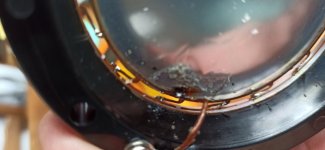I bought one for a compression whose diaphragm had been "repaired" by soldering copper wires to the broken fingers. The "Lase" diaphragm rubs in the air gap, I have 15% distortion...Hey since you have the ja6681b do you think this is for real or fake
https://www.ebay.com/itm/LASE-Repla...2349624.m46890.l49286&mkrid=711-127632-2357-0 it might be a blessing or not
Attachments
If you have time, this might be worth fixing.
1) Is there any play in diaphragm placement when you tighten the screws? If there is, try moving the diaphragm up, then to one side, and finally to the other side. It is a trial and error process while you measure with REW. Loosen screws, push diaphragm, retighten screws, measure and repeat.
2) If this does not succeed, you could try massaging the suspension to reposition the coil where it belongs. I’ve done this on cone drivers and I suspect it might work on a compression drivers too - but have not tried. If you wish to, give the diaphragm a mini workout with your fingers by pushing it in and out in a pistonic movement. Place fingers around the dome, just inside the suspension.
3) I think the screw holes and wire design allow this: remove and rotate the diaphragm X degrees before screwing it back in.
4) Triple check that the gap is clean. I suppose you have already.
5) In last resort, take the diaphragm off and verify with a calliper that the coil is perfectly circular. Beware of damaging the coil.
1) Is there any play in diaphragm placement when you tighten the screws? If there is, try moving the diaphragm up, then to one side, and finally to the other side. It is a trial and error process while you measure with REW. Loosen screws, push diaphragm, retighten screws, measure and repeat.
2) If this does not succeed, you could try massaging the suspension to reposition the coil where it belongs. I’ve done this on cone drivers and I suspect it might work on a compression drivers too - but have not tried. If you wish to, give the diaphragm a mini workout with your fingers by pushing it in and out in a pistonic movement. Place fingers around the dome, just inside the suspension.
3) I think the screw holes and wire design allow this: remove and rotate the diaphragm X degrees before screwing it back in.
4) Triple check that the gap is clean. I suppose you have already.
5) In last resort, take the diaphragm off and verify with a calliper that the coil is perfectly circular. Beware of damaging the coil.
You are supposed to run a low-ish frequency with a tone generator and fasten the diaphragm where you here the least amount of distortion. It can also be measured in realtime.
Hi, Pierre,If you have time, this might be worth fixing.
1) Is there any play in diaphragm placement when you tighten the screws? If there is, try moving the diaphragm up, then to one side, and finally to the other side. It is a trial and error process while you measure with REW. Loosen screws, push diaphragm, retighten screws, measure and repeat.
2) If this does not succeed, you could try massaging the suspension to reposition the coil where it belongs. I’ve done this on cone drivers and I suspect it might work on a compression drivers too - but have not tried. If you wish to, give the diaphragm a mini workout with your fingers by pushing it in and out in a pistonic movement. Place fingers around the dome, just inside the suspension.
3) I think the screw holes and wire design allow this: remove and rotate the diaphragm X degrees before screwing it back in.
4) Triple check that the gap is clean. I suppose you have already.
5) In last resort, take the diaphragm off and verify with a calliper that the coil is perfectly circular. Beware of damaging the coil.
Sorry for the late reply...
The inner edge of the diaphragm was rubbing on the inside of the air gap. No way to adjust in any way: clearly the coil diameter is too small...I returned the diaphragm and am still looking for a solution...
Here is the last compression, with the original "repaired" diaphragm.
I removed the two damping foams (transformation by Meyer Sound) and resoldered one of the coil wires...
I'm going to try to unsolder the soldered copper wires and replace them... I saw that there could be sheets of copper-beryllium alloy, but that seems complicated to me... I'll perhaps try with a material that remains quite flexible, like silicone...
Regards
Attachments
This is all so sad guys.
I might as well throw my motors into the dumpster.
Still got the Beryllium Copper Sheets here but absolutely no time to do anything.
Did the dome of the Lase diaphragms look to fit the phase plug dome?
I might as well throw my motors into the dumpster.
Still got the Beryllium Copper Sheets here but absolutely no time to do anything.
Did the dome of the Lase diaphragms look to fit the phase plug dome?
Do not despair! Does anyone know if the original Yamaha diaphragms are Duralumin or regular aluminum?
Pierre, Gary Dahl and/or Lynn Olson might know. But in any case, isn't the biggest concern how to find a solution for duplicating the beryllium fingers, or finding another material-and structural design-that performs as perfectly? That's where the expensive OEM engineering would seem to be necessary.Do not despair! Does anyone know if the original Yamaha diaphragms are Duralumin or regular aluminum?
It might even be worthwhile to bounce the problem and goal off Troy Crowe. He and/or those he knows might have one or more solutions
for redesigning this diaphragm to accurately replicate its remarkable sound. https://josephcrowe.com/
But to make it both affordable for us and profitable to Troy we'd have to maximize the size of a group buy of diaphragms once a prototype is measured and subjectively tested by those here with the most experience and EE chops like Pierre, Rewind, Klaus et al.
for redesigning this diaphragm to accurately replicate its remarkable sound. https://josephcrowe.com/
But to make it both affordable for us and profitable to Troy we'd have to maximize the size of a group buy of diaphragms once a prototype is measured and subjectively tested by those here with the most experience and EE chops like Pierre, Rewind, Klaus et al.
I just send this message to Lase:
Hello,
Many audio enthusiasts and professional public address sound system companies are in need of the Meyer Sound MS 1401a diaphragms but unfortunately the Lase diaphragms voice coil is a tiny bit to small and therefore not usable.
Would you be willing to contact the manufacturer to let him know the issue?
We are gladly sending in a MS 1401a compression driver for manufacturing purposes if needed.
Regards,
Klaus Freis
Hello,
Many audio enthusiasts and professional public address sound system companies are in need of the Meyer Sound MS 1401a diaphragms but unfortunately the Lase diaphragms voice coil is a tiny bit to small and therefore not usable.
Would you be willing to contact the manufacturer to let him know the issue?
We are gladly sending in a MS 1401a compression driver for manufacturing purposes if needed.
Regards,
Klaus Freis
My reasoning is the following:
If the Lase diaphragms are manufactured right they provide us with a voice coil dome assembly that we can use to glue our routed S shaped surround onto
The beryllium material of the surrounds is not a secret recipe. It's used in millions of relays and is sold fairly cheap as sheets. Got a few sheets here although with wrongly delivered thickness.
We covered all this a few pages back.
The content of beryllium in the copper is in the one digit area and routing with a small tip routing bit should not pose any problems.
If we can get the shape of just one S finger AutoCad will do the rest for us to get what we want.
Klaus
If the Lase diaphragms are manufactured right they provide us with a voice coil dome assembly that we can use to glue our routed S shaped surround onto
The beryllium material of the surrounds is not a secret recipe. It's used in millions of relays and is sold fairly cheap as sheets. Got a few sheets here although with wrongly delivered thickness.
We covered all this a few pages back.
The content of beryllium in the copper is in the one digit area and routing with a small tip routing bit should not pose any problems.
If we can get the shape of just one S finger AutoCad will do the rest for us to get what we want.
Klaus
Knowing first hand that the Radian 850pb wasn't far behind in sonics above 500 hz and superior above about 7khz I would really like to try this S finger shaped surround on it.
It would certainly lower FS and prevent compression artefacts under the surround.
Klaus
It would certainly lower FS and prevent compression artefacts under the surround.
Klaus
Apogee Sound used to modify stock titanium diaphragms by punching holes in the surrounds of EV DH1A diaphragms.
Appears Meyers Sound also did (does) similar modifications to lower FS on some of their diaphragms after the JA-6681 were history:

Although the holes may compromise reliability, the modifications probably are less problematic than the JA-6681 finger suspension assembly, too many fiddly moving parts..
Art
Appears Meyers Sound also did (does) similar modifications to lower FS on some of their diaphragms after the JA-6681 were history:
Although the holes may compromise reliability, the modifications probably are less problematic than the JA-6681 finger suspension assembly, too many fiddly moving parts..
Art
Yes Art,
Years back we had this discussion about the Klipsch/Atlas drivers of which I had send two units to Dietmar. I suggested to drill holes in the surrounds and it was actually a real success. Strong output from about 200hz.
Years back we had this discussion about the Klipsch/Atlas drivers of which I had send two units to Dietmar. I suggested to drill holes in the surrounds and it was actually a real success. Strong output from about 200hz.
Any new developments towards a new diaphragm design?
Just wanted to share this: Arez mentioned here at post 15649 that there's a reconer in Japan who offers replacement suspensions of his own design. May want to check with him for contact info.
https://www.diyaudio.com/community/threads/beyond-the-ariel.100392/post-7958160
Just wanted to share this: Arez mentioned here at post 15649 that there's a reconer in Japan who offers replacement suspensions of his own design. May want to check with him for contact info.
https://www.diyaudio.com/community/threads/beyond-the-ariel.100392/post-7958160
"Slot" tweeter? A ribbon? An AMT? Makes/models?That's actually why I prefer a slot tweeter instead of the normally used bullet.
I prefer Fane ST5022 over the JBL. Sounds more airy and refined.
Never understood why Fane gave up on the whole Studio series. Outstanding clarity and efficiency through all of the Line.
Never understood why Fane gave up on the whole Studio series. Outstanding clarity and efficiency through all of the Line.
Another lovely but long discontinued make/model-and with no replacement drivers?I prefer Fane ST5022 over the JBL. Sounds more airy and refined.
https://www.fane-international.com/search/ST5022
- Home
- Loudspeakers
- Multi-Way
- Info on the Yamaha JA-6681 compression driver


